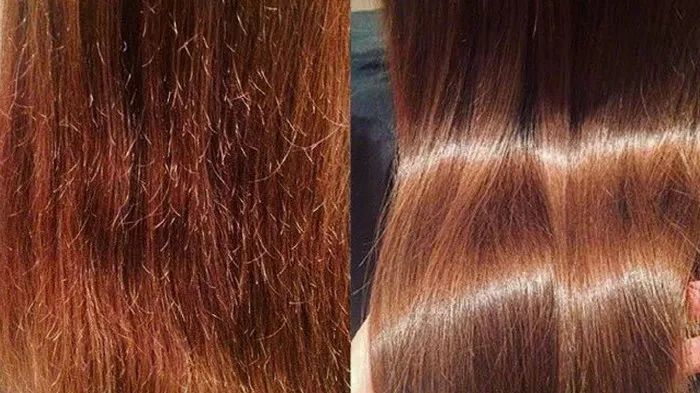Hair, often considered the crowning glory, can sometimes become the bane of existence due to split ends. These pesky little strands of damaged hair where the tips begin to split and fray not only mar the appearance of our locks but also indicate underlying issues with hair health. Identifying split ends is crucial for effective management. They often manifest as ragged strands, prone to frequent tangling, and a general lack of smoothness and luster.
Causes of Split Ends:
Several factors contribute to the development of split ends, and understanding them is the first step towards prevention. Heat styling ranks high among the culprits, with excessive use of hot hairstyling tools such as straighteners and curling irons leading to weakened hair shafts. Similarly, overuse of hair products, including styling gels, mousses, and serums, can weigh down hair and cause breakage.
Chemical treatments, particularly hair coloring, also take a toll on hair health. The harsh chemicals in dyes and bleaches strip the hair of its natural oils, leaving it brittle and prone to splitting. Environmental factors like exposure to sun, wind, and pollution further exacerbate the problem by depleting the hair’s moisture and making it more susceptible to damage.
Treatment Options:
While split-end treatments cannot magically reverse existing damage, they play a crucial role in preventing further deterioration and maintaining the overall health of the hair. These treatments typically work by sealing the hair cuticle, thereby minimizing further splitting, and providing temporary softness, smoothness, and shine.
One popular treatment option is the use of products that bond to the hair cuticle, creating a protective seal. These products effectively bind broken hair fibers together and offer a temporary solution to split ends. Additionally, treatments that prevent further breakage by providing a barrier against environmental stressors are highly beneficial.
Furthermore, split-end treatments serve as a stopgap measure when visiting a salon for a professional haircut is not feasible. By temporarily improving the appearance and texture of split ends, these products buy time until a proper trim can be scheduled.
Best Products for Split Ends:
When it comes to choosing the best products for split ends, several options stand out for their effectiveness in repairing and preventing further damage. Philip Kingsley Bond Builder Split End Repair is a top contender, known for its ability to bind broken hair fibers together when activated with heat. This innovative product not only repairs split ends but also strengthens the hair shaft, resulting in smoother, healthier-looking locks.
Another notable product is Oribe Split End Seal, which not only provides shine and smoothness but also offers protection against future breakage. Its lightweight formula coats the hair shaft, effectively sealing split ends and preventing them from worsening over time.
Prevention Strategies:
While treating split ends is essential, preventing their occurrence in the first place is equally crucial for maintaining healthy hair. Adopting preventive strategies can significantly reduce the risk of split ends and promote overall hair health.
Limiting heat styling is paramount in preventing split ends. Whenever possible, opt for heat-free styling methods or use heat protectant products to minimize damage. Additionally, practicing gentle hair handling techniques, such as avoiding vigorous brushing and detangling wet hair with a wide-tooth comb, can help prevent breakage and minimize the risk of split ends.
Regular trims are essential for keeping split ends at bay. Schedule routine haircuts every 5–6 weeks for shorter styles and every 8–10 weeks for longer styles to remove damaged ends and promote healthy hair growth. Investing in a quality hair care routine, including moisturizing shampoos and conditioners tailored to your hair type, can also contribute to overall hair health and reduce the likelihood of split ends.
In conclusion, managing split ends requires a multi-faceted approach that addresses both treatment and prevention. By understanding the causes of split ends, choosing the right products, and adopting preventive strategies, you can enjoy smoother, healthier-looking hair and bid farewell to split ends for good.
FAQs
Can you actually repair split ends?
Unfortunately, once a hair strand splits, the damage is irreversible. You can’t technically repair split ends completely. However, you can employ preventive measures and treatments to minimize their appearance and prevent further damage.
What is the best thing for split ends?
Prevention is key when it comes to split ends. Regular trims every 6-8 weeks can help prevent split ends from worsening. Additionally, using a moisturizing shampoo and conditioner can keep your hair hydrated and less prone to breakage. Incorporating a nourishing hair mask or oil treatment into your routine can also help keep split ends at bay.
Which hair treatment is best for split ends?
Various hair treatments can help improve the appearance of split ends. Look for products containing ingredients like keratin, argan oil, or coconut oil, which can help strengthen and nourish the hair shaft. Additionally, protein treatments can temporarily mend split ends and strengthen the hair.
How do you fix split ends without cutting?
While the only permanent solution for split ends is trimming them off, there are ways to temporarily mend them. Applying a small amount of leave-in conditioner or serum to the ends of your hair can help smooth them down and reduce frizz. Avoiding heat styling tools and minimizing exposure to harsh chemicals can also help prevent split ends from forming in the first place.


